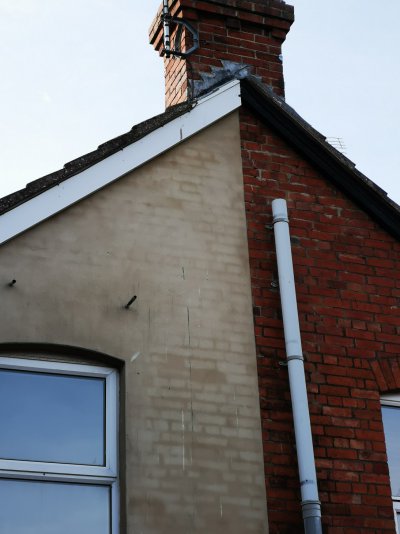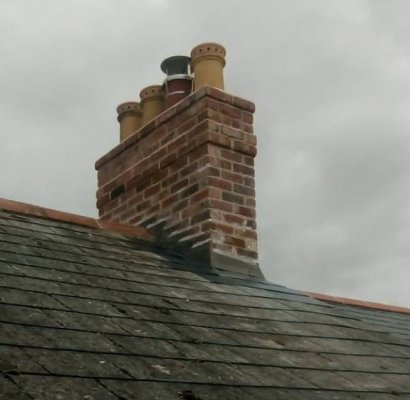Hi all,
Second item on the priority list - chimney. I know the shared chimney at the rear of our 1911 semi is leaking, both around the flashing and down the chimney itself (it's open at the top (no pot etc.) and in a poor state of repair. Neighbour repointed and rebuilt his 'half' a year ago (before we brought the house) but didn't touch our side -get the impression there wasn't a lot of neighbourly love before! I've arranged for a roofer to come and rebuild the top of the chimney, add a pot and cowl to prevent rain ingress and replace all the flashing. That should sort out the water issue. My question relates to allowing the chimney to dry. As you can see from the picture the chimney breast external wall is quite wet and I assume I am seeing moisture attempting to evaporate through the mortar behind the render? It has been very wet recently so this is the worse it has looked. The inner chimney breast walls are also a little damp (according to the 'damp-meter' - I know their limitations) and some wall paper has peeled but there are no major damp signs internally. The fire place at the base of the chimney is in the kitchen and as been converted into a cupboard, the actual chimney blocked off with a closure plate that is unsupringly rusting.
If we carry out the the repairs to the chimney, stop the water getting in and leave it open at the top will that be enough to allow it to dry out? Is it also a good idea to remove the closure plate and vent at the bottom as well? We do not plan to use any heat source in the chimney. Any insight very much welcome.
Cheers!
Sam
Second item on the priority list - chimney. I know the shared chimney at the rear of our 1911 semi is leaking, both around the flashing and down the chimney itself (it's open at the top (no pot etc.) and in a poor state of repair. Neighbour repointed and rebuilt his 'half' a year ago (before we brought the house) but didn't touch our side -get the impression there wasn't a lot of neighbourly love before! I've arranged for a roofer to come and rebuild the top of the chimney, add a pot and cowl to prevent rain ingress and replace all the flashing. That should sort out the water issue. My question relates to allowing the chimney to dry. As you can see from the picture the chimney breast external wall is quite wet and I assume I am seeing moisture attempting to evaporate through the mortar behind the render? It has been very wet recently so this is the worse it has looked. The inner chimney breast walls are also a little damp (according to the 'damp-meter' - I know their limitations) and some wall paper has peeled but there are no major damp signs internally. The fire place at the base of the chimney is in the kitchen and as been converted into a cupboard, the actual chimney blocked off with a closure plate that is unsupringly rusting.
If we carry out the the repairs to the chimney, stop the water getting in and leave it open at the top will that be enough to allow it to dry out? Is it also a good idea to remove the closure plate and vent at the bottom as well? We do not plan to use any heat source in the chimney. Any insight very much welcome.
Cheers!
Sam


